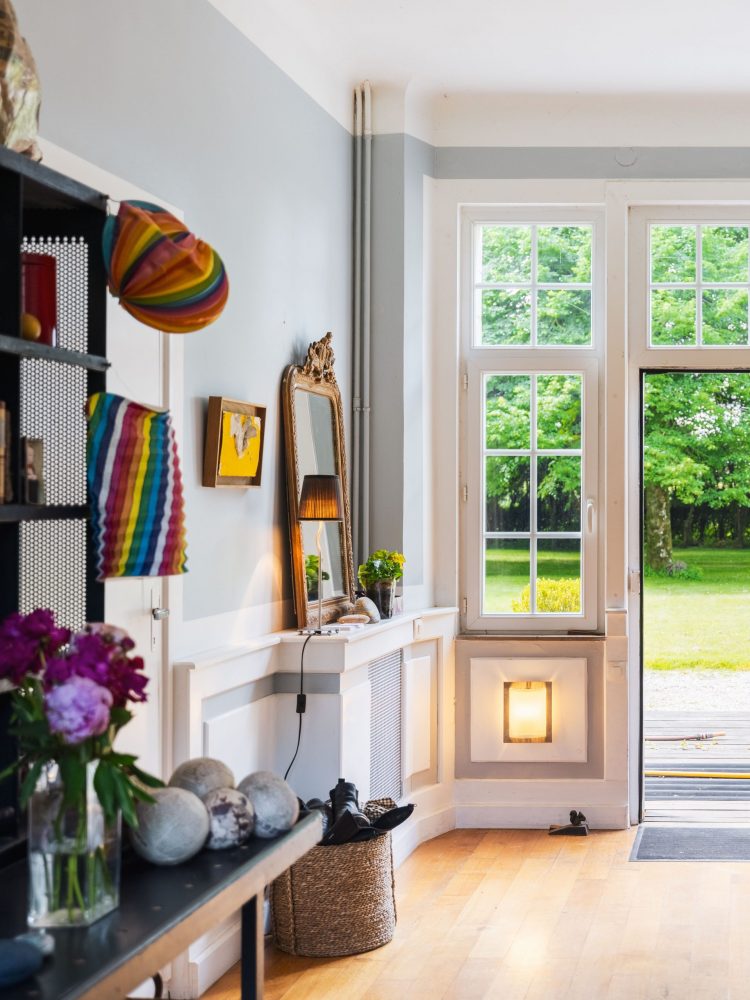Domaine
Des chanoines blancs
Nature, heritage & sharing
The name of the domain refers to the history of the abbey and its founders, an order of Canons Regular of Prémontré founded in the 12th century.
The white monks owe their name to their unbleached linen robes, which whiten with washing.
Their motto: “Write sparingly, but accomplish without reserve”.
Sleep
at the domain
Why not sample the charm of the estate for a night?
Discover our organic and fresh breakfasts, as well as our breakfasts, aperitifs and picnic baskets.
Discover
the guests house
The guests house overlooks the garden and park.
Furniture: Eames Plastic DAR chair (Vitra), Signal table lamp (Jieldé), Gae Aulenti coffee table, “In Out” tables by Paola Navone in blue ceramic, Fermob nomad lamps, Business and Pleasure parasol, antique furniture, Formica stool, vintage Tolix chairs, etc.
Samaras room: a king-size bed and en suite shower room and WC (upstairs)
Sycamore room: two single beds, available as a single or adjoining double bed, separate WC and shower room (upstairs).
And two sofa beds by the fireplace on the ground floor.
1 or 2 separate bedrooms and 2 sofa beds: sleeps 4 to 6.
Lounge, dining room, study.
The abbey gîte has a small fully-equipped kitchen (microwave, oven, ceramic hob, fridge, freezer, crockery).
Private terrace with garden furniture, brazier and lanterns. Stove with a supply of logs.
There is a staircase to the two upstairs bedrooms.
Discover
The domain
Sustainable tourism
Hosts Also Take Part At Our Side
The Domaine des Chanoines Blancs is first and foremost a place where you can take a break, rest and recharge your batteries in the calm, nature and beauty of the area. Early morning meditations, forest paths, trees in spring bursting with birds, naps in the sun, peaceful horses.
The estate promotes a number of reflexes linked to global warming but also to respect for living things: mobility, waste management, respect for resources, pellet heating, discreet lighting, rainwater harvesting, crafts, short circuits, choice of materials, energy costs, partnerships with local craftsmen and professionals.
The buildings and natural environment are maintained with organic products, without pesticides (and using manure from the horses). Organic henhouse, organic vegetable garden.
The principle is to design solutions that respect the obligations associated with the Historic Monument classification, while at the same time innovating to mark a profound and lasting change in lifestyles and consumption patterns, for owners and guests alike.
A BIRD PROTECTION LEAGUE REFUGE
The Domain is an LPO Refuge (Ligue de protection des Oiseaux) and as such is committed to biodiversity: feeders, food, no plant protection products, etc. It is home to an exceptional number and variety of birds (blackbirds, tits, jays, turtle doves, hens and cockerels, geese, ducks, etc.).


A COMMITMENT TO THE REGION
The Domaine has increased the number of partnerships with local craftsmen, and encourages short circuits and collaboration: from the baker to the jam-maker, from the soap-maker to the weaver of linen sheets, from the artisan roaster to the chocolate-maker. We work together for the Opal valleys, the Montreuil area and the Opal Coast.
Heritage
history of an outstanding site
A priory founded around 1130 in Aulnoy (commune of Maresquel) was transferred in 1156 to the hamlet of Grémecourt as an abbey under the patronage of Saint-André. The Abbey of Saint André aux Bois is an abbey of the Order of Canons Regular of Prémontré, founded in the 12th century at Gouy-saint-André (Pas-de-Calais), on the Canche-Authie interfluve plateau. Thierry, Bishop of Amiens, consecrated the church in 1163.
Founded in 1153 by Abbot Anscher, the Abbey is a descendant of the Abbey of Saint-Josse de Donmartin in Tortefontaine. During the second half of the twelfth century and the first half of the thirteenth century, the monks of the abbey cleared many forests in the Canche-Authie valley to make the land suitable for farming.
Attacked several times, held to ransom and destroyed by fire and pillage, the monastery regained its prosperity in the 17th and 18th centuries with 14 canons and a new church. The abbey was rebuilt again in 1751 before being ransacked during the Revolution. It is the farm buildings erected in 1752 and 1762 by Claude Brunion, known as “the outbuildings”, as well as a few architectural features (entrance porch, side gate in the current park) that can be seen today.
The history of the Abbey and the architectural quality of the buildings justified the listing of the buildings as Historic Monuments in 1970.
creators
For over 10 years, the owners have created and run the Moulin de la Ronce in Alluyes (28), a charming bed and breakfast, the only establishment to be classified 5 épis Gîtes de France for this département at the time (2010-2020).
The establishment has won accolades from TV magazines (France 5, France 2), interior design magazines (Côté Ouest) and the general public (Le Figaro Magazine, Paris-Match). The Eure-et-Loir ADRT hosted a number of influencers (“Bestjobers”), as well as journalists (Le Figaro, etc.). In 2012, it was listed in the Michelin Guide (the only B&B in the 28 for 2 years) and has been referenced in the best travel guides, including foreign ones (Hobbs, Alastair Sawdays, etc.).
They have a strong taste for decoration, art and design, a passion for horse-riding, and also like to “cultivate their garden”.
The Domaine des Chanoines Blancs is a house where works of art, books, records and ceramics, turned and fired on the premises, rub shoulders.
These are the values that inspire them: authenticity, generosity, beauty, respect for heritage and sharing.
Decoration, art and design
A BATH OF LIGHT AND NATURE
We like to start with a clean, uncluttered environment and gradually create the right balance between natural materials, beautifully crafted objects, 20th-century works of art and design, contemporary collectables and antiques.
All the furniture is made up of family heirlooms, pieces of furniture and objects found at flea markets or signed by famous designers. We like to pay tribute to the work of young designers and artists.
You’ll find furniture, lamps and objects by design icons such as Louis Poulsen, Ray and Charles Eames, Gae Aulenti, Nogushi, Pierre Paulin, Konstantin Grcic, Paola Navone, Christophe Pillet, 5.5 Designers, Robin Day, Jasper Morrison, Philippe Starck and Mategot, as well as Formica and chairs designed for the MOMA in New York.
The decor has a relaxed elegance, a chic, timeless sobriety, reminiscent of the old monasteries: the white of the hemp and ceramics, a neutral, minimal but warm colour palette, beautiful materials, a strong taste for living, vibrant materials: wood, stone, linen, hemp, natural fibres. With a keen eye for composition, materials and light.
The bedrooms and shared rooms are light and airy, with generous windows that bathe you in light and nature. An invitation to contemplate, to the rhythm of nature.
The feeder gardens
an exceptional park that plunges us into the heart of life









The domain is made up of several gardens, some of which have been inherited from the past and still retain some of their stone and brick boundary walls. Lime trees, beech trees, ash trees, chestnut trees, cherry trees, willows and an avenue of poplars, some of which are over a hundred years old.
The owners wanted to recreate the nurturing gardens that existed in the days of the monks: orchard, vegetable garden like a parish priest’s garden, flower gardens and aromatic and medicinal herb gardens… inspired by archive documents.





























